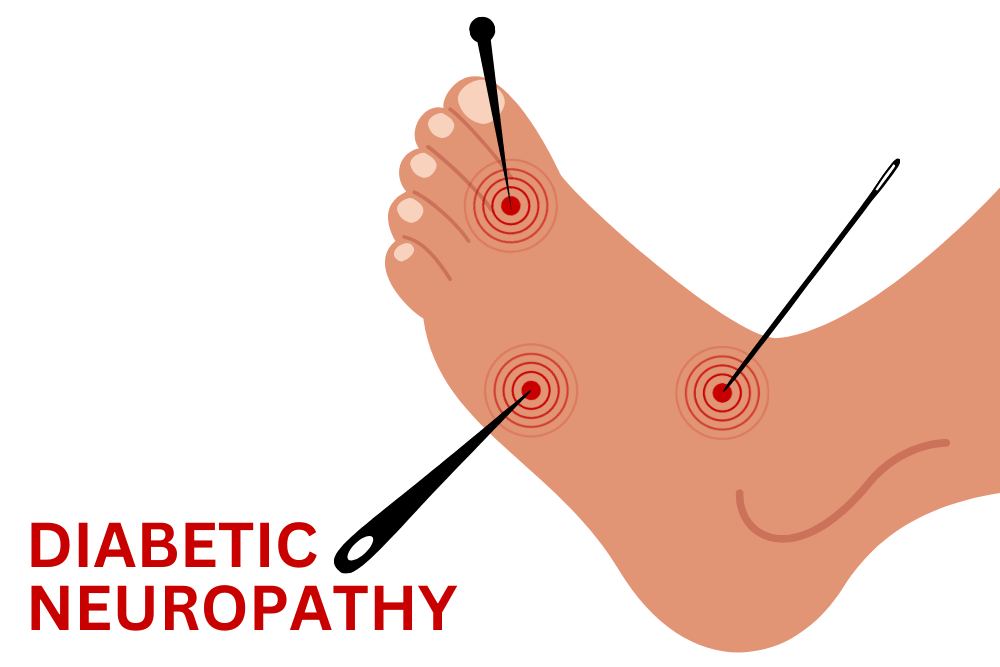Diabetes can have a wide range of effects on the body, and one of the most common and serious complications is diabetic neuropathy, which can significantly impact foot health. Neuropathy refers to damage to the nerves, and in people with diabetes, it usually affects the feet and legs. The worst part is that neuropathy can progress silently, as it often starts with subtle symptoms that may go unnoticed until the damage is more severe.
In this post, we’ll explain what diabetic neuropathy is, how to recognize its symptoms, and what you can do to manage it and protect your feet from serious complications.
What is Diabetic Neuropathy?
Diabetic neuropathy is a condition that occurs when high blood sugar levels over time cause nerve damage throughout the body. When blood sugar isn’t well controlled, the nerves become damaged due to poor circulation and high glucose levels. The condition most often affects the feet, but can also affect the hands, arms, and other parts of the body.
There are several types of diabetic neuropathy, but the most common in people with diabetes is peripheral neuropathy, which affects the feet and legs.
Symptoms of Diabetic Neuropathy
It’s essential to recognize the signs of diabetic neuropathy early on to prevent further damage. Here are some symptoms to watch for:
- Numbness or tingling: A common early sign of neuropathy, this can make your feet feel “asleep” or like they’re buzzing.
- Pain: People with diabetic neuropathy may experience sharp, stabbing pain, or even a sensation of burning in their feet.
- Loss of sensation: One of the most dangerous aspects of diabetic neuropathy is the loss of feeling in the feet. Without proper sensation, a person may not notice small injuries like cuts, blisters, or sores, increasing the risk of infections.
- Changes in the shape of your feet: Over time, neuropathy can cause structural changes to the foot, including deformities like Charcot foot, which occurs when the bones in the foot are weakened and break.
- Unusual sensations: Some people with neuropathy experience sensations like crawling, itching, or electric-shock feelings in their feet.
If you experience any of these symptoms, it’s important to seek medical advice to prevent further damage.
Why Is Neuropathy Dangerous for Your Feet?
The main issue with diabetic neuropathy in the feet is the loss of sensation. People with this condition may not feel pain, heat, cold, or discomfort, which are essential signals for noticing injuries. For example, if there’s a blister or a small wound, you might not be able to feel it until it becomes infected or more severe. This delayed response can lead to complications such as:
- Foot ulcers: Due to poor circulation and nerve damage, diabetic foot ulcers are common and can become infected if not treated promptly.
- Infections: Without feeling, you may not notice when an infection starts. If an infection is left untreated, it can spread, leading to the need for amputation in extreme cases.
- Blisters and calluses: Because you can’t feel when something is rubbing against your feet, calluses or blisters may form, leading to potential open wounds that can become infected.
Managing and Preventing Diabetic Neuropathy
Although diabetic neuropathy can’t always be reversed, early diagnosis and good management can slow down its progression and minimize the impact. Here are some tips for managing and preventing complications:
- Control your blood sugar: Keeping your blood sugar levels within a healthy range is crucial to prevent further nerve damage. Regular monitoring and insulin management can help.
- Check your feet regularly: Inspect your feet daily for cuts, blisters, sores, redness, or any changes in the skin. Since you may not feel these problems due to neuropathy, regular foot inspections are crucial.
- Keep your feet clean and dry: Wash your feet every day with warm (not hot) water and dry them thoroughly, especially between the toes.
- Wear well-fitting shoes: Proper footwear is key to preventing blisters, calluses, and other foot problems. Avoid tight shoes or shoes that rub against your feet.
- Moisturize your feet: Dry skin can crack and lead to infections. Use a moisturizer specifically designed for diabetic foot care, but avoid putting lotion between your toes.
- See a healthcare provider regularly: Regular checkups with a podiatrist or healthcare professional are essential for early detection of any foot issues related to diabetic neuropathy.
When to See a Doctor
If you experience any of the following, it’s important to seek medical attention immediately:
- Severe pain or discomfort that doesn’t improve.
- Infections, such as redness, swelling, or pus, especially if you have any open sores.
- Wounds or cuts that don’t heal after a few days.
- Changes in the shape of your feet or any signs of Charcot foot.
Early treatment can prevent serious complications, including amputation.
Conclusion: Protect Your Feet, Protect Your Health
Diabetic neuropathy is a serious complication of diabetes, but with proper care and attention, you can protect your feet and manage the condition effectively. Early detection of symptoms, maintaining healthy blood sugar levels, and following a consistent foot care routine can significantly reduce the risk of severe complications.
If you suspect you’re experiencing any symptoms of diabetic neuropathy, don’t wait—talk to your healthcare provider today. Your feet are essential to your overall health, so take steps now to keep them healthy for years to come.

Type 2 Diabetes: Is It Really Reversible?
A recent National Geographic article [link] explores how type 2 diabetes could be reversible with the right approaches. This condition, which affects millions of people worldwide, has long been considered a chronic and progressive disease. However, recent research challenges this perception and suggests that with lifestyle changes and the right approach, remission is possible. The

How Do GLP-1 Drugs Compare? A Breakdown of Ozempic, Mounjaro, and Trulicity
GLP-1 receptor agonists have revolutionized diabetes management, with drugs like Ozempic, Mounjaro, and Trulicity leading the market. But how do these medications compare in terms of effectiveness, side effects, and patient outcomes? Let’s explore their differences and what they mean for diabetes patients. Understanding GLP-1 Medications GLP-1 receptor agonists mimic a natural hormone that helps

Why Has Medicare Spending on Diabetes Medications Skyrocketed in 5 Years?
In the past five years, Medicare spending on diabetes medications has increased nearly fivefold, reaching $35.8 billion in 2023. This surge has been primarily driven by the growing use of GLP-1 drugs such as Ozempic, Mounjaro, and Trulicity. But what is behind this cost escalation, and how does it affect patients and the U.S. healthcare

The Gut Microbiota and Blood Sugar Control: A Hidden Connection
The human gut is home to trillions of bacteria that play a crucial role in digestion, immune function, and even metabolism. Recent research has revealed a fascinating link between the gut microbiota and blood sugar regulation, shedding light on how the balance of microbes in our intestines can influence diabetes risk and overall metabolic health.

The Dawn Phenomenon: Why Blood Sugar Rises While You Sleep
For many people with diabetes, waking up with high blood sugar levels can be frustrating—especially if they didn’t eat anything overnight. This early-morning spike in blood glucose is known as the Dawn Phenomenon, and it happens due to natural hormonal changes in the body. But why does it occur, and how can it be managed?

The Influence of Red Light on Blood: Can It Improve Diabetes?
Type 2 diabetes is a metabolic disease characterized by insulin resistance and elevated blood glucose levels. In the search for complementary alternatives to improve glycemic control, red light therapy has gained attention due to its potential to enhance circulation, reduce inflammation, and optimize cellular function. But what does science say about it? ✨ What is

